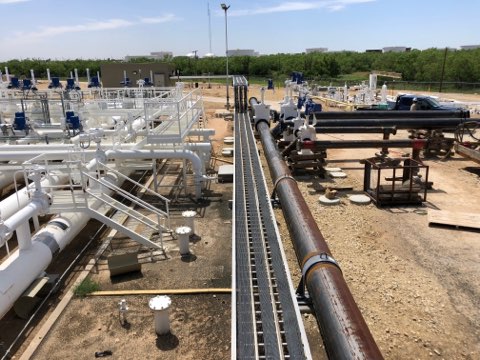All Concerning Oil Field Equipment and Pipeline Equipment: Key Insights and Necessary Information
Oil field equipment and pipeline systems play a critical duty in the oil and gas market. They are crucial for the efficient extraction and transport of hydrocarbons. Key parts, such as piercing rigs and tank, directly influence operational success. Improvements in technology pledge to improve safety and security and effectiveness. Recognizing these elements is vital for anyone associated with or interested in this complex sector, as it establishes the phase for much deeper exploration of industry practices.

Overview of Oil Field Equipment
As the demand for oil remains to grow, understanding the tools made use of in oil areas ends up being increasingly important. Oil field equipment includes a wide variety of equipment and tools vital for expedition, removal, and processing. Trick elements include piercing rigs, which are essential for getting to oil reservoirs, and manufacturing devices, such as separators and pumps, that assist in the removal process. Superior Rentals reviews. In addition, tank play a substantial role in holding petroleum prior to transportation. Safety and security devices, consisting of blowout preventers and pressure gauges, guarantees operational safety and performance. Each tool features cohesively to enhance production and keep efficient operations. Experience with this devices is essential for experts in the sector to ensure successful operations and adherence to security standards
Types of Drilling Rigs and Their Applications
Drilling rigs function as the foundation of oil extraction operations, with numerous kinds developed for certain geological problems and functional needs. The most usual types include rotating exploration rigs, which utilize a rotating drill little bit to penetrate the earth, and wire tool rigs, known for their percussion exploration method. For offshore procedures, jack-up rigs and semi-submersible rigs supply security and assistance in aquatic settings. Additionally, directional boring rigs allow operators to pierce at angles, getting to deposits that are not vertically available. Each gear kind has one-of-a-kind advantages, optimizing effectiveness and safety based on the drilling setting. Selecting the appropriate gear is important for making the most of resource extraction while decreasing environmental impact and operational costs.

Necessary Pipeline Equipment and Their Features
Pipeline infrastructure is vital for the transportation of oil and gas from extraction sites to refining centers and end-users. Numerous important devices elements facilitate this procedure. Pipelines themselves function as the main avenues, made to hold up against high stress and harsh materials. Pump stations are critical for maintaining circulation by increasing pressure along the pipeline. Shutoffs play an important duty in regulating circulation and isolating areas for upkeep. Furthermore, installations and ports ensure protected joints between pipeline areas. Checking systems, including circulation meters and pressure sensing units, are important for finding leaks and maximizing flow rates. Ultimately, pigging equipment is used for upkeep and cleaning, guarding pipeline honesty and efficiency. With each other, these elements create the backbone of a reputable pipeline system.
Innovations and Technologies in Oil and Gas Equipment

Safety And Security and Upkeep Practices in the Oil Market
While the oil sector has made substantial strides in innovation and effectiveness, the significance of durable safety and security and maintenance methods can not be overemphasized. top article Reliable safety and security methods are crucial to secure employees and the environment, reducing the threat of mishaps and resource spills. Regular assessments and upkeep of tools help recognize prospective concerns prior to they escalate, guaranteeing functional honesty. Training programs for employees are vital, highlighting the importance of safety recognition and emergency feedback procedures. Additionally, adherence to market policies and standards cultivates a society of safety. Carrying out advanced monitoring innovations can even more improve maintenance practices, allowing for real-time evaluations of tools conditions. Eventually, prioritizing safety and upkeep is indispensable to the sustainability and success of the oil market.
Frequently Asked Questions
What Are the Environmental Impacts of Oil Field Equipment?
The ecological effects of oil field equipment include environment damage, water contamination, and air pollution (Superior Rentals reviews). In addition, devices malfunction can result in spills, detrimentally impacting wild animals and environments, highlighting the need for rigorous policies and monitoring
Just How Is Oil Field Equipment Moved to Remote Locations?
Carrying oil field equipment to remote areas typically includes specialized lorries, helicopters, or barges. Logistics business coordinate routes, making sure equipment shows up securely and successfully, taking into consideration terrain and accessibility to reduce delays and take full advantage of performance.
What Governing Criteria Govern Oil Field Equipment?
Governing standards governing oil field equipment largely include safety and security, environmental management, and operational effectiveness guidelines. Agencies such as OSHA and EPA apply these policies to guarantee risk-free techniques and decrease ecological impact in oil extraction operations.
What Abilities Are Needed to Operate Oil Area Equipment?

Just How Do Oil Prices Affect Equipment Need and Use?
Oil costs considerably affect devices need and more usage. Higher prices usually result in increased expedition and manufacturing tasks, driving need for equipment. Conversely, lower rates might lead to lowered operations and decreased requirement for equipment.